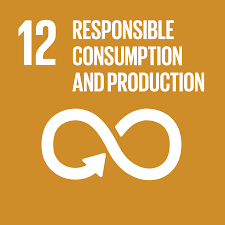The Problem With Fast Fashion
- Mahek

- Aug 25, 2020
- 5 min read
Updated: Sep 1, 2020
This article is focused on the following UN Sustainable Development Goals:
fast fashion
noun
inexpensive clothing produced rapidly by mass-market retailers in response to the latest trends.

Most see the fast fashion industry as a way to cater to the masses- allowing those who only have so much disposable income to still express their sense of style in the most affordable and chic manner. The idea behind this industry and its quick production of the ever-changing runway for cheap seems simply perfect; especially when these brands, such as H&M and Zara, have lines which offer sustainably produced products- after all, what more could a consumer possibly ask for? However, therein lies the issue. These brands know their demographic- the youth- and their awareness of our interest in the climate crisis and all that it entails means they must cater to this sustainable future, lest they lose their consumers. This phenomenon is known as greenwashing but worst of all is the fact that greenwashing is the least of our worries when it comes to fast fashion.
In 1980 the average American bought 12 items per year, twenty years ago each garment that was bought was worn for double the amount of time it is today, and until the 1940s fast fashion didn’t exist. But fast forward about 70 years and you’ll find that the only segment of the fashion industry which has grown in the last 15 years is fast fashion. Now, instead of those 12 items per year, the average American buys 68 pieces per year, and half of these items are worn only thrice. It seems with a rising wealth disparity fast fashion is more relevant than ever before.

In the modern era, fast fashion is the perfect industry- making trendy clothes quick, cheap, and disposable- as opposed to legacy brands which have seasonal releases, selling only a few designs annually. High-end brands have a two-year process of designing, sourcing, manufacturing, and distributing. Whereas with quick response manufacturing, the designing process is cut down, sourcing is erased- rather these brands keep raw materials on standby- and they are able to distribute a multitude of designs rapidly, numerous times a year. By knocking off designer brands, the designing process becomes almost nonexistent: because the logo is never replicated such items aren’t determined as counterfeits, thus the whole process is legal and can be scaled down to 4 months.
But more than just quick response manufacturing, there’s another essential branch of retailing: dynamic assortment. This essentially means brands release new products daily. Thus, instead of following the legacy brand’s bi-annual seasons, the fast fashion industry has almost 52 seasons a year- otherwise known as weeks. However, this is the issue, with new designs weekly and new shipments thrice a week, Inditex (the manufacturer for brands such as Zara, Pull ‘n’ Bear, and Bershka) produces 1,597,260,495 items a year (this was the figure for 2018).

This causes massive detriment to the environment- the textile industry causes more emissions than all international flights and maritime shipping combined. This issue seeds from the initial creation of the fabric itself. The textiles used in the making of one sweater utilise 10330 L of water- which is a 24 year supply of drinking water. Synthetic fabrics such as polyester, nylon, and plastic are even worse, using 342 million gallons of oil per year. But the worst fabric of all is viscose- which comes from ancient and threatened forests- the accumulation of which causes massive amounts of waste. After the deforestation has occurred, the wood which was harvested is pumped and processed, and only 30% of it is used.
However, this is solely the process of creating fabrics; the chemical process of dying, etc, is another major aspect in the creation of our clothing, which causes unparalleled amounts of pollution, especially to bodies of water that numerous are dependent upon.

Even still, many may think it’s inexorable for the public to control this excessive pollution, after all, we do need clothes. Thus, let’s look at an aspect of the fashion industry that we can control: the disposal of garments. If we cannot force companies to produce their goods responsibly, then let us aim for responsible consumption, SDG 12- as in the past, we haven’t done so. The average American throws away 80 lbs of clothes per year. Even those of us who donate our clothes are still contributing to this pollution; Salvation Armies in New York dispose of 18 tons of unwanted clothes every three days. The clothes which they can’t sell in such centres are shipped off to the developing world- especially Africa-where they remain in landfills for months on end before they are finally burned.
Some of these facts are largely known, and in a hectic response to the public’s proliferation of concern in regards to the environment, companies have responded by greenwashing. Consumers are told that their products are made from an amalgamation of reused plastics, and various lines are advertised as sustainable, or companies promote donating old clothes in exchange for a discount- which again, benefits only them. Yet, because the wording they use in these commercials is so vague it can’t truly be known how much of the product is actually made from recycled plastics; in fact most times it’s only a modicum of the item which uses any recycled material at all. For instance, Zara and H&M have sustainability lines in which the only morsel of the garment which is actually recycled is the price tag.
Evidently, the fashion industry needs to be held accountable for their actions, but more than that we are the last generation who can truly make a change in regards to the climate crisis. It’s time we take action, SDG 13, be it through advocating through movements such as #FridaysForFuture or making the smallest of changes to our lifestyles. The good news in all of this is that these minuscule tweaks can benefit the environment significantly. Simply wearing your clothes for nine months longer can reduce your carbon footprint for that garment by 30%. Furthermore, by buying a secondhand item in place of one new product this year, you could save 6 lbs of CO2 emission- the equivalent of removing half a million cars off the road for a year. This could be the impact of your singular action because remember, change starts with you.
Works Cited
“US Retail Sales:” YCharts, ycharts.com/indicators/us_retail_sales.
Thomas, Dana. Fashionopolis: the Price of Fast Fashion & the Future of Clothes. Apollo, 2020.
“Media.” Home, www.inditex.com/investors/investor-relations/annual-reports.
Kozlowski, Anika. “Fast Fashion Lies: Will They Really Change Their Ways in a Climate Crisis?” Salon, Salon.com, 2 Aug. 2019, www.salon.com/2019/08/04/fast-fashion-lies-will-they-really-change-their-ways-in-a-climate-crisis_partner/.
Butler, Sarah. “Is Fast Fashion Giving Way to the Sustainable Wardrobe?” The Guardian, Guardian News and Media, 29 Dec. 2018, www.theguardian.com/business/2018/dec/29/fast-fashion-giving-way-sustainable-wardrobe.
Abram, Cleo. “Why This Gucci Knockoff Is Totally Legal.” Vox, Vox, 14 Sept. 2018, www.vox.com/2018/9/14/17831458/designer-knockoffs-legal.






Comments